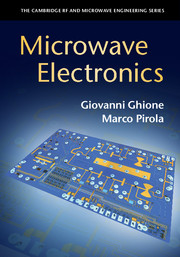Book contents
- Frontmatter
- Dedication
- Contents
- Preface
- Notation and Symbols
- 1 A System Introduction to Microwave Electronics
- 2 Passive Elements and Circuit Layout
- 3 CAD Techniques
- 4 Directional Couplers and Power Dividers
- 5 Active RF and Microwave Semiconductor Devices
- 6 Microwave Linear Amplifiers
- 7 Low-Noise Amplifier Design
- 8 Power Amplifiers
- 9 Microwave Measurements
- 10 CAD Projects
- Index
- References
3 - CAD Techniques
Published online by Cambridge University Press: 10 November 2017
- Frontmatter
- Dedication
- Contents
- Preface
- Notation and Symbols
- 1 A System Introduction to Microwave Electronics
- 2 Passive Elements and Circuit Layout
- 3 CAD Techniques
- 4 Directional Couplers and Power Dividers
- 5 Active RF and Microwave Semiconductor Devices
- 6 Microwave Linear Amplifiers
- 7 Low-Noise Amplifier Design
- 8 Power Amplifiers
- 9 Microwave Measurements
- 10 CAD Projects
- Index
- References
Summary
Modeling of Linear and Nonlinear Blocks
In an integrated microwave circuit, passive devices (such as resistors, inductors, capacitors, transformers, simple and coupled transmission lines) are linear blocks, and can therefore be characterized by linear models. Transistors (field effect or bipolar) and diodes are, instead, nonlinear components also in DC or quasi-static conditions, although they can behave in an approximately linear way under small-signal operation. Linear passive reactive components (such as linear inductors and capacitors) are with memory in the (v, i) port variables; nonlinear reactive elements, like the capacitances of pn or metal-semiconductor junctions, on the other hand are also associated with active components, such as transistors. Thus, MMICs generally include linear and nonlinear elements, memoryless or with memory.
The small-signal approximation, where the transistor characteristics are linearized in the neighborhood of the DC operating point, is well suited to the design of high-gain or low-noise amplifiers; in small signal conditions the active device is approximated as a linear block with memory. The simulation of distortion and power saturation occurring in power amplifiers (but also in low-noise and high-gain amplifiers in the upper limit of their spurious free dynamic range, see Sec. 8.2.3) require instead a nonlinear transistor model, often including linear and nonlinear memory effects.
In analog circuits, linear n-ports are conveniently modeled in the frequency domain, selecting conventional variables (such as voltages and currents) as the component input and output, or exploiting circuit variables that are more suited to the analysis and characterization of microwave circuits, such as the power waves, see Sec. 3.2. A linear n-port can be represented through a linear relationship between input and output variables; if we identify the component status in terms of the Fourier transforms of port voltages and currents, according to the choice of the input and output variable sets we obtain wellknown frequency-domain models such as the series (or current-driven, or impedance) representation and the parallel (or voltage-driven, or admittance) representation [1].
Although a linear element is completely described by a proper set of parameters conveniently sampled over the frequency band of interest, in many cases an equivalent circuit approach is preferred. The equivalent circuit is an approximate model of the component, whose topology and element parameters have to be fitted on measured (or physically simulated) characteristics.
- Type
- Chapter
- Information
- Microwave Electronics , pp. 87 - 128Publisher: Cambridge University PressPrint publication year: 2017



